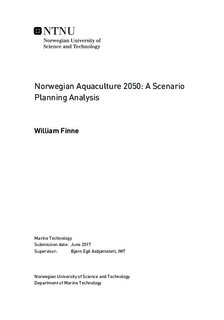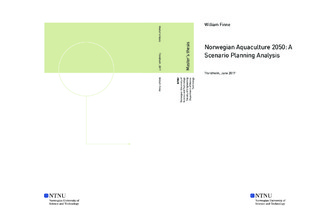| dc.description.abstract | The objective of this thesis is to create a set of scenarios and action plans for the Norwegian aquaculture industry s development towards 2050. The purpose of doing this is to encourage the decision-makers within the industry to consider possible future scenarios that they would not otherwise and to serve as an aid towards achieving the industry s 2050-goals.
To form a basis to perform a scenario planning analysis, an individual study of the Norwegian aquaculture industry s current situation, the development of the industry since its beginning, its 2050-goals, the prerequisites to achieve the 2050-goals, a PESTEL-analysis, a competitive force analysis and a SWOT-analysis is performed. Further, to ensure the necessary input to perform the analysis, six interviews with seven relevant stakeholders of the industry are conducted.
To perform the scenario planning analysis, the SRI approach proposed by Stanford Research Institute is used. This is a qualitative method and is one of the most commonly used methods for scenario planning. The SRI approach consists of eight steps; 1) Analysing the decisions and strategic concerns, 2) Identifying the key decision factors, 3) Identifying key environmental forces, 4) Analysing the environmental forces, 5) Defining scenario logic, 6) Elaborating the scenarios, 7) Analysing the implications for key decision factors and 8) Analysing implications for decisions and strategies.
Within step 5) of the approach, a cross-impact analysis is performed to analyse the effect the different environmental forces have on each other and a morphological analysis is performed to generate plausible combinations of factor variations within the scenario themes. The resulting scenarios are created in step 6) and the action plans are created in step 7) and 8). After the scenarios have been created a validation analysis is performed to ensure that the scenarios serve as an adequate basis for decision-making. The criteria the scenarios are evaluated by are 1) Plausibility, 2) Consistency, 3) Creativity and coherence and 4) Relevance. To check for consistency, the scenarios are subjected to a consistency analysis.
The main results of this thesis work are four scenarios named Dry Well, Puddle, Ocean and Poseidon which all describe possible future states of the industry in 2050 and the development leading up to these states.
Dry Well is the worst-case scenario and describe a future where the industry experience a worsening in the situation of all the force-groups that affect the industry, where the environmental situation is the main driver. The result of the worsened situation is that the export volume from the Norwegian aquaculture industry has dropped to 150.000 tonnes in 2050.
Puddle describe a future where the industry has not managed to improve the environmental issues of the industry and therefore has lost the political will for an upscaling of the production. The result of this is that the export volume from the Norwegian aquaculture industry in Puddle has stagnated at 950.000 tonnes in 2050.
River describe a future where the industry has successfully achieved exposed aquaculture and by doing so they have eliminated the environmental issues at these locations. However, they have not improved the environmental situation at the locations near the shore and this has caused the politicians to be reluctant for upscaling at these locations. The result of this is that the export volume from the Norwegian aquaculture industry is 2.110.000 tonnes in 2050.
Poseidon is the best-case scenario and describe a future where the industry has reached all their 2050-goals. This is a ripple effect of a choice the industry made to in collaboration solve the environmental issues which became very successful. This combined with good marketing efforts and an increase in global demand has resulted in the export volume from the Norwegian aquaculture industry reaching 5.000.000 tonnes in 2050.
For each scenario, a corresponding action plan is created. These are intended to describe the implications of the scenario with respect to the key decision factors, determine whether the information about the future validate the original assumptions, determine what the scenarios imply for the design and timing of strategies, describe what threats and opportunities the scenarios suggest, describe what critical issues emerge from the scenarios, determine which cases deserve to be addressed by specific contingency plans, determine what kind of flexibility and resilience that is necessary from the industry s planning perspective and determine what factors deserve monitoring. A common denominator in the action plans is that achieving environmental sustainability should receive a higher priority if the industry is to reach the 2050-goals. Another common denominator is that the environmental issues are inhibiting the growth of the industry in all the scenarios where the industry does not achieve their 2050-goals. Therefore, all the action plans suggest that the environmental issues should be addressed by specific contingency plans.
The scenarios and action plans created fulfil the objective as they all describe possible future developments which may encourage the decision-makers presented to them to consider developments they would not have otherwise. Further, since there are many advantages associated with implementing scenario planning as part of a company s long-term strategy, doing so may enable the companies to better seize opportunities and avoid threats in the future given that they are aware of the pitfalls of using scenario planning. Therefore, since the scenarios and action plans may cause the stakeholders presented to them to see the value of implementing scenario planning, the thesis fulfils the aim of serving as an aid towards achieving the 2050-goals.
The conclusion of this thesis is that the scenarios and action plans fulfil the objective of the thesis, but that for the actors within the industry to have more use of a scenario planning analysis they should implement it as part of their own company s long-term strategy.
The recommendations for further work that would improve the quality of the analysis is to perform the whole analysis in collaboration with the involved stakeholders instead of only using them as input. For individual companies to have more use of the thesis work, the recommendation is to use this thesis as a guideline of how to perform a scenario planning analysis and to implement scenario planning as part of their own long-term strategy. Within the area of scenario planning literature, the recommendation for further work is to perform more research on the effectiveness of scenario planning as there in the literature only was found one study doing this. | |

